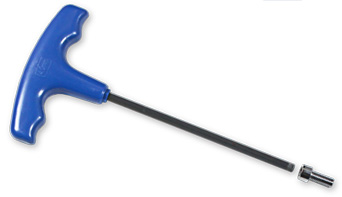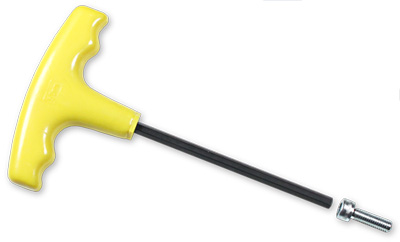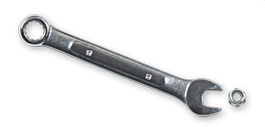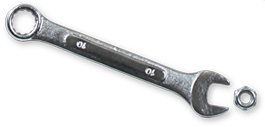XLAB INSTALLATION TIPS
1. USE THE CORRECT TOOLS
Full sized workshop tools are required for proper and secure installation. Shown below are typical full sized tools. These are from www.harborfrieght.com and are inexpensive. Others from www.craftsman.com are excellent. DO NOT use Mini folding tools as they will not tighten the parts sufficiently.
TORQUE WRENCHES
We recommend the use of a Torque wrench in order to correctly tighten the fastenings to 30 in.lbs of torque. If you do not have a Torque wrench then use the wrenches shown below.
TOOLS FOR TIGHTENING SCREWS
At XLAB we use two screw sizes. The smaller M5 size is used on all XLAB Carriers and has a 5mm threaded shank and a 4mm hexagonal socket in the head of the screw.
SHOWN- TYPICAL 4mm 'T' HANDLE HEXAGONAL WRENCH WITH M5 SOCKET HEAD SCREW

The larger M6 screw size is only used on CERVÉLO™ specific carriers like the Carbon Sonic and
Sonic Wing. The M6 size has a 6mm threaded shank and a 5mm hexagonal socket in the head
of the screw.
SHOWN-TYPICAL, 5mm 'T' HANDLE HEXAGONAL WRENCH WITH M6 SOCKET HEAD SCREW

TOOLS FOR TIGHTENING NUTS
All the nuts we use have a piece of Nylon inside them that grips the screw and prevents the
nut from loosening due to vibration. Once the screw reaches the Nylon insert you have to
apply twice the force to the tool as the screw carves its way into the Nylon. They are called
NYLOC nuts.
At XLAB we use two nut sizes. The smaller M5 size is used on all XLAB Carriers and has a 5mm
internal thread and measures 8mm across the flats of the nut.
SHOWN-TYPICAL 8mm WRENCH WITH M5 NYLOC NUT

The larger M6 nut size is only used on CERVÉLO™ specific carriers like the Carbon Sonic and
Sonic Wing. The M6 size has a 6mm internal thread and measures 10mm across the flats of
the nut.
SHOWN-TYPICAL 10mm WRENCH WITH M6 NYLOC NUT

2. TIGHTENING TIPS
LOCKING METHODS
At XLAB we use four different methods of locking depending on the needs of the design- Internal Lock Washers, External Lock Washers, Nyloc Nuts, or Loctite Coated Screws.

Lock Washers
You will not notice any increase in force required when Lock Washers are used in a design. However the teeth on the washers will grip the parts on either side of them and require a slight extra force when loosening the screws. If tightening into a Nyloc nut you should tighten with your full strength. If tightening into the Hexagonal Aluminum Stabilizers, do not over tighten because you may strip the threads. Note that the screws that go into the Stabilizers on the Carbon Sonic and Sonic Wing have a red Loctite glue that will partially set after 10 minutes and fully lock in to the screw after 24 hours.

Nyloc Nuts
These are commonplace in the aircraft industry and our designers thought they would be a perfect product for our highly durable Hydration carriers. When tightening screws into Nyloc Nuts the force required to tighten the screws will double, when the screw reaches the Nylon in the nut. You must keep on tightening and you will see the end of the screw come through the end of the nut. Tighten with your full strength. If you try and use the nuts a second time they will not have the same locking strength and should be replaced.
Loctite Coated Screws
These are used on many of our products and this special thread locking coating is also used by Ford, General Motors, Mercury Marine, and Yamaha. The red coated Loctite has the same features as the Blue Loctite (also known as Threadlocker) available in Hardware stores. It sets in 10 minutes and fully locks after 24 hours. It does require a considerable force to remove screws that have fully set, so ensure you have your carrier and cages in the optimum position before you tighten the screws into the red coating area. You should not reuse red coated screws, instead use either uncoated screws and add one drop of Blue Loctite or purchase replacement hardware kit from XLAB.
Craig V Turner
Founder and Chief Designer





